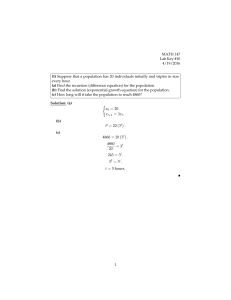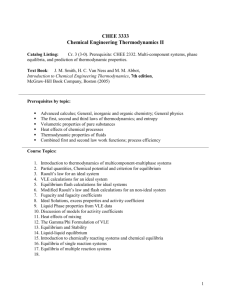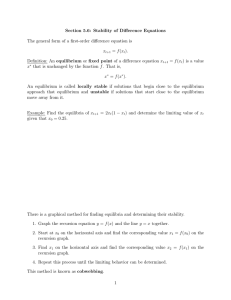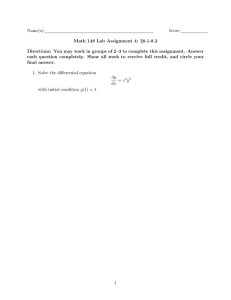CARESS Working Paper #96-01 Multiplicity of Equilibria Christian Ghiglino Mich Tvede
advertisement
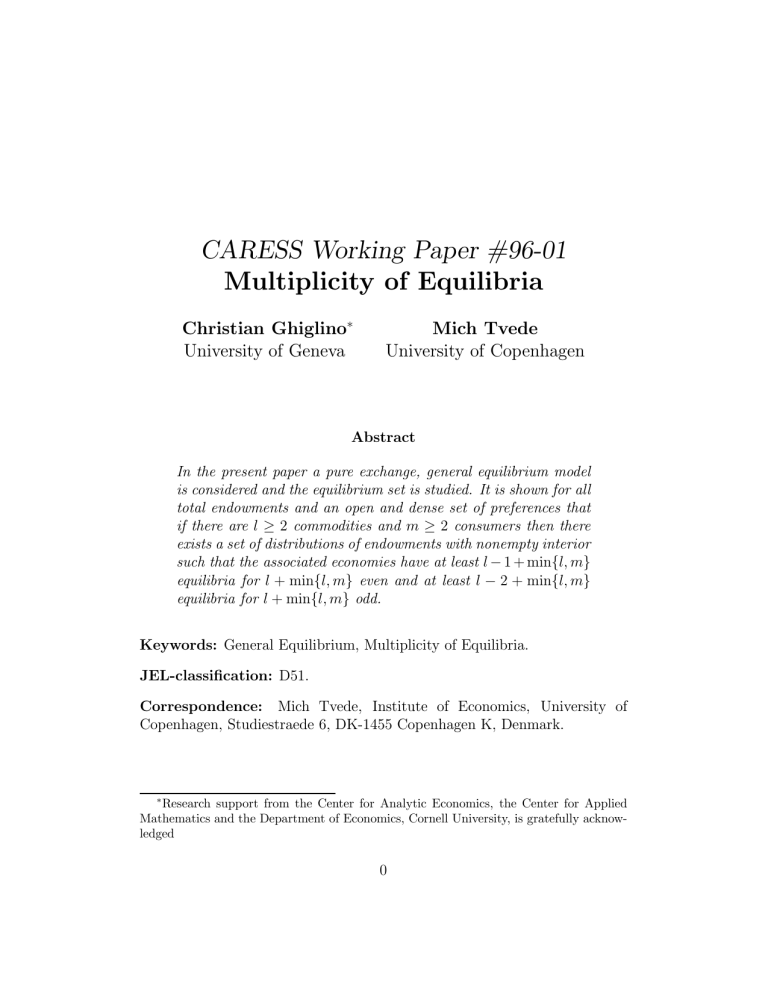
CARESS Working Paper #96-01
Multiplicity of Equilibria
Christian Ghiglino¤
University of Geneva
Mich Tvede
University of Copenhagen
Abstract
In the present paper a pure exchange, general equilibrium model
is considered and the equilibrium set is studied. It is shown for all
total endowments and an open and dense set of preferences that
if there are l ¸ 2 commodities and m ¸ 2 consumers then there
exists a set of distributions of endowments with nonempty interior
such that the associated economies have at least l ¡ 1 + minfl; mg
equilibria for l + minfl; mg even and at least l ¡ 2 + minfl; mg
equilibria for l + minfl; mg odd.
Keywords: General Equilibrium, Multiplicity of Equilibria.
JEL-classi¯cation: D51.
Correspondence: Mich Tvede, Institute of Economics, University of
Copenhagen, Studiestraede 6, DK-1455 Copenhagen K, Denmark.
¤
Research support from the Center for Analytic Economics, the Center for Applied
Mathematics and the Department of Economics, Cornell University, is gratefully acknowledged
0
1
Introduction
In general, economic agents have to coordinate their actions in order to make
them mutually compatible and thereby obtain a feasible state. This coordination among agents can be obtained through a form of consistency of
expectations, i.e. all agents expect the same state to prevail and therefore
make mutually compatible actions. In economies with a unique equilibrium
it is natural that agents expect the same state to prevail, namely the equilibrium, thus uniqueness of equilibrium leads to coordination. However for
economies with multiple equilibria it is less clear how and on what agents
coordinate, so multiplicity of equilibria can lead to market failures due to
lack of coordination.
Market failures can take the form of sunspot equilibria, where agents
coordinate their actions but the outcome of the coordination is determined
by \sunspots" which are stochastic variables. Therefore it is hardly surprising
that sunspot equilibria are closely related to multiplicity of equilibria. Indeed
multiplicity of equilibria combined with restricted market participation lead
to the existence of sunspot equilibria in general equilibrium economies as
shown by Balasko, Cass and Shell in [3].
Clearly the number of equilibria depend on the form of the excess demand function for the economy in question and a crucial issue in relation
to excess demand functions is whether Walras' law and homogeneity characterize the set of excess demand functions. This question was studied by
Sonnenschein, Mantel and Debreu [4, 7, 9] and the most general answer was
probably given by Debreu: Any continuous function, which satis¯es Walras'
law and homogeneity and has compact domain in the set of positive prices, is
excess demand function for some economy with at most as many consumers
as commodities. However, in order to obtain this result total endowments as
well as preferences are considered to be parameters.
Excess demand functions' lack of characteristics may leave the impression
that little can be said about economies beyond the theorems on existence of
equilibrium and the welfare theorems. However if economies are parametrized
by endowments, i.e. preferences are ¯xed, then they possess some structure
as shown by Balasko in [2] and using this structure the issue of multiplicity of
equilibria can be addressed. The fact that there exists a set of distributions of
endowments with nonempty interior such that the associated economies have
at least as many equilibria as commodities has been used in [3] to establish
1
the existence of sunspot equilibria, but no formal theorem has been stated.
Moreover di®erentiable topology can be used to show that the set of excess
demand functions in some sense is a small subset of the set of functions which
satisfy Walras' law and homogeneity and have the set of positive prices as
domain as done by Balasko in [1].
In the present paper economies are parametrized by the distribution of endowments, i.e. total endowments and preferences are considered to be ¯xed,
and within this framework the relation between distributions of endowments
and multiplicity of equilibria is studied. Through a ¯bration of the equilibrium set and an application of index theory it is shown that if there are l ¸ 2
commodities and m ¸ 2 consumers then there exists a set of distributions
of endowments with nonempty interior such that the associated economies
have at least l ¡ 1 + minfl; mg equilibria for l + minfl; mg even and at least
l ¡ 2 + minfl; mg equilibria for l + minfl; mg odd. The result is established
for consumption sets without lower bounds, but subsequently it is extended
to consumption sets with lower bounds through a translation of endowments
and preferences. The result of the present paper deviates from the results
of Debreu, Mantel and Sonnenschein in the sense that total endowments as
well as preferences are considered to be ¯xed and in the sense that only two
consumers are needed independently of the number of commodities.
The results of the present paper can be applied to static economies with
restricted market participation in order to ¯nd economies with sunspot equilibria as already mentioned. For stationary dynamic economies the results
can be applied to ¯nd economies with multiple steady states because stationary dynamic economies can be reduced to static economies whose equilibria
are steady states as shown by Kehoe and Levine in [6]. However while the
relation between local indeterminacy of steady states and the existence of
sunspot equilibria has been explored by Spear, Srivastava and Woodford in
[10] among others, the relation between multiplicity of steady states and
sunspot equilibria is less explored. Moreover there is no relation between
multiplicity of steady states and local indeterminacy of steady states.
The paper is organized as follows: In section 2 the model is introduced;
in section 3 the equilibrium set is endowed with a ¯bre bundle structure and
some useful results are established; in section 4 index theory is introduced
and the main result is established; in section 5 the main result is extended
to consumption sets with lower bounds; and ¯nally in section 6 some ¯nal
remarks are o®ered.
2
2
The Model
A general equilibrium model with l ¸ 2 commodities and m ¸ 2 consumers is
considered. Consumer i is described by her consumption set Xi , her endowment !i and her utility function ui . The consumers are supposed to verify
the following assumptions
{
(A.1) Xi = Rl .
(A.2) !i 2 Rl .
(A.3) ui 2 C 1 (Xi ; R) and u¡1
i (a) is bounded from below for all a 2 R.
(A.4) ui has positive derivatives, Dui 2 C 1 (Xi ; Rl++ ).
(A.5) ui has negative de¯nite Hessian, y T D2 ui (x)y 2 R¡¡ , for all x 2 Xi
and y 2 Rl n f0g.
All assumptions are standard for the di®erentiable general equilibrium
model except (A.5) which is a little stronger than the usual assumption
of strict quasi-concavity. The set of utility functions is endowed with the
Whitney topology and the set of economies is endowed with the product
topology. In section 5 it is discussed how the results can be extended to
models in which consumption sets are bounded from below.
Consumer i maximizes her utility function subject to her budget constraint
max ui (x)
s.t. p ¢ xi = p ¢ !i = wi ;
where xi 2 Rl is her consumption and p 2 Rl++ is the price. The solution
to this problem is her demand and if the price is varied then her demand
function fi : Rl++ £ R ! Rl is obtained. The demand function satis¯es the
budget constraint and homogeneity and it is smooth. If
m
X
i=1
fi (p; p ¢ !i ) ¡ !i = 0
then (p; !1 ; : : : ; !m ) is an equilibrium.
3
3
Fibration of the Equilibrium Set
It seems to be hard to study how the number of equilibria is related to the
distribution of endowments due to the fact that demand functions depend
on endowments in a quite complicated way. Therefore, the equilibrium set is
endowed with a ¯bre bundle structure, see [2].
De¯nition 1 For (p; w) 2 Rl++ £Rm the ¯bre F (p; w) ½ Rl++ £Rlm consists
of all pairs (p; !) for which
(B.1) p ¢ !i = wi for all i 2 f1; : : : ; mg.
(B.2)
Pm
i=1
fi (p; wi ) =
Pm
i=1
!i .
It is easy to verify that ¯bres are linear manifolds of dimension (l ¡ 1)(m ¡ 1)
embeded in the equilibrium set. Call the projection of ¯bres, F (p; w), on
their second coordinates !-¯bres, G(p; w), i.e. F (p; w) = fpg £ G(p; w).
Every ¯bre contains one and only one no trade equilibrium characterized
by !i = fi (p; wi ) for all i 2 f1; : : : ; mg, while there is some exchange for all
other distributions of endowments.
Lemma 1 Suppose that
(C.1)
Pm
i=1
fi (p(h); wi (h)) = r for all h 2 f1; : : : ; ng.
(C.2) rank [ p(1) ¢ ¢ ¢ p(n) ] = n.
then the intersection of the n !-¯bres (G(p(h); w(h)))nh=1 is a non-empty
linear manifold of dimension (l ¡ n)(m ¡ 1).
Proof The intersection is characterized by the following system of equations
p(h) ¢ !i = wi (h) for all h and i
m
X
!i = r
i=1
Clearly, if the n prices are linearly independent then l ¡ n coordinates of
endowment for the consumers are determined by the other n coordinates
and the endowment of one consumer is determined by endowments of the
other m ¡ 1 consumers.
Q.E.D.
4
According to lemma 1 no !-¯bres intersect if and only if all Pareto optimal allocations are supported by the same prices. Thus the question of
whether or not economies have multiplicity of equilibria is equivalent to the
question of whether or not economies have Pareto optimal allocations which
are supported by di®erent prices.
Lemma 2 Suppose that the economy (r; (ui )m
i=1 ) has n Pareto optimal allocations (p(h); x(h))nh=1 2 Rl++ £ Rlm with
rank [ p(1) ¢ ¢ ¢ p(n) ] = n;
where the p(h)'s are supporting prices, then there exists a distribution of
P
endowments on all !-¯bres with m
i= fi (p; wi ) = r for which the associated
economy has at least n equilibria.
Proof There exists a h 2 f1; : : : ; ng such that
rank [ p(1) ¢ ¢ ¢ p(h ¡ 1) p p(h + 1) ¢ ¢ ¢ p(n) ] = n;
According to lemma 1 the intersection of the n ¯bres is non-empty and
economies with distributions of endowments in the intersection have n equilibria.
Q.E.D.
Remark Lemma 2 can be deduced from [3].
As shown in the next lemma most economies have Pareto optimal allocations which are supported by di®erent prices, thus most economies have
multiple equilibria.
Lemma 3 For all r 2 Rl and all n 2 f1; : : : ; lg there exists an open and
dense set of utility functions such that the economy (r; (ui )m
i=1 ) has n Pareto
l
lm
n
optimal allocations (p(h); x(h))h=1 ½ R++ £ R with
rank [ p(1) ¢ ¢ ¢ p(n) ] = n;
where the p(h)'s are supporting prices.
5
Proof There is an isomorphism between Pareto optimal allocations and
Qm
¹i [, where u¹i = supx ui (x) for i 2 f2; : : : ; mg, due to the fact that
i=2 ] ¡ 1; u
Pareto optimal allocations are solutions to the following problem
max u1 (x1 )
s.t. u2 (x2 ) ¸ u2 ; : : : ; um (xm ) ¸ um
Pm
i=1 xi = r
where (u2 ; : : : ; um ) 2
Qm
i=2 ]
¡ 1; u¹i [.
\Openness" This part of the proof is omitted due to its triviality.
\Density" All economies (r; (ui )m
i=1 ) have a continuum of Pareto allocations.
n
Consider n pairs of prices and Pareto optimal allocations (p(h); (xi (h))m
i=1 )h=1
0
0
with xi (h) 6= xi (h ) for all i and h 6= h .
Let jy 2 C 1(Rl ; [0; 1]) be a partition of unity with center y, outer radius
ro and inner radius ri , i.e.
jy (x) =
(
0 for ky ¡ xk ¸ ro
1 for ky ¡ xk · ri
l
where ro = 31 min kxi (h) ¡ xi (h0 )k and ri = 21 ro . For all (y)m
i=1 ; z 2 R there
exists ² 2 R++ such that ui (x) + ±kDui (yi )kjyi (x)z ¢ x satis¯es (A.3), (A.4)
and (A.5) for all i 2 f1; : : : ; mg and all ± < ².
Suppose that
rank [ p(1) ¢ ¢ ¢ p(h) ] = h
p(h + 1) 2 span [ p(1) ¢ ¢ ¢ p(h) ]
and perturb ui (x) into ui (x) + ±kDui (xi (h + 1))kjxi (h+1) (x)z ¢ x then (xi (h +
1))m
i=1 is also a Pareto optimal allocation for the \perturbed" economy because the derivatives of the perturbed utility functions are proportional. If
z 2
= span [ p(1) ¢ ¢ ¢ p(h) ] then Dui (xi (h + 1)) + ±kDui (xi (h + 1))kz 2
=
[ p(1) ¢ ¢ ¢ p(h) ] and (xi (h + 1))m
is
supported
with
a
linearly
independent
i=1
price.
Q.E.D.
Lemma 1, lemma 2 and lemma 3 can be combined in order to obtain the
following corollary.
6
Corollary 1 For all total endowments and an open and dense set of utility
functions there exist distributions of endowments on all !-¯bres such that
the associated economies have at least as many equilibria as the number of
commodities.
In order to obtain stronger results than corollary 1 demand functions as
well as properties of the equilibrium set have to be exploited.
Due to Walras' law, only equilibrium conditions for the ¯rst l ¡ 1 commodities have to be considered and due to homogeneity only prices for the
¯rst l ¡ 1 commodities have to be considered, i.e. the price for the last commodity can be normalized to one. Let gi denote the demand function for
consumer i without the last coordinate and let q denote the price without
the last coordinate.
On ¯bres the Jacobian matrices of the excess demand functions are a±ne
functions, i.e.
X
Dq
gi (p; p ¢ !i ) ¡ !i = M + KY
i
where
2
M
m
X
@fi1
@fi1 1
+
f
@p1 @wi i
..
.
6
6 i=1
6
= 6
6
6
m
6 X
@fil¡1
4
i=1
2
K
Y
6
6
6
= 6
6
6
6
4
2
6
= 6
4
@p1
¢¢¢
m
X
@fi1
i=1
@fi1 l¡1
+
f
@pl
@wi i
..
.
m
X
@fil¡1 1
@fil¡1 @fil¡1 l¡1
+
+
f ¢¢¢
f
l¡1
@wi i
@wi i
i=1 @p
1
@fm¡1
@f11
@f 1
@f 1
¡ m
¢¢¢
¡ m
@w1 @wm
@wm¡1 @wm
..
..
.
.
l¡1
l¡1
@f1l¡1 @fm
@fm¡1
@f l¡1
¡
¢¢¢
¡ m
@w1
@wm
@wm¡1
@wm
!11 ¡ f11
..
.
3
!1l¡1 ¡ f1l¡1
7
..
7
.
5
¢¢¢
l¡1
l¡1
1
1
!m¡1
¡ fm¡1
¢ ¢ ¢ !m¡1
¡ fm¡1
thus M and K are constant on ¯bres.
7
3
7
7
7
7
7
7
7
5
3
7
7
7
7
7
7
7
5
Consider l ¡ 1 ¯bres (F (p(h); w(h)))l¡1
i=1 , if
rank [ q(1) ¢ ¢ ¢ q(l ¡ 1) ] = l ¡ 1;
then the endowments for consumer i have to satisfy
(!i1 ; : : : ; !il¡1 ) = (wi (1) ¡ !il ; : : : ; wi (l ¡ 1) ¡ !il )Q¡1
in order to be in the intersection of the !-¯bres, where
Q = [ q(1) ¢ ¢ ¢ q(l ¡ 1) ]:
Hence on the intersection of the l ¡ 1 ¯bres the determinants of the Jacobian
matrices are a±ne functions, i.e.
j Dq
m
X
i=1
gi (p(h); p(h) ¢ !i ) ¡ !i j = s(h) +
m¡1
X
si (h)!il
i=1
for h 2 f1; : : : ; l ¡ 1g. In the second part of the appendix the coe±cients
s(h); s1 (h); : : : ; sm¡1 (h) are calculated.
4
The Main Theorem
At an equilibrium (p; !), if
rank Dq
m
X
i=1
gi (p; p ¢ !i ) = l ¡ 1
then there exist an open neighborhood, -, of ! and a smooth function,
l¡1
p : - ! R++
£ f1g, such that
m
X
i=1
gi (p(!); p(!) ¢ !i ) ¡ !i = 0
for all ! 2 - and the equilibrium is called regular, otherwise it is called
singular. The index of a regular equilibrium is
i(p; !) = (¡1)l¡1 sign j Dq
m
X
i=1
gi (p; p ¢ !i ) j:
and if all equilibria of an economy are regular then the sum of their indices
is +1 according to the Poincar¶e-Hopf Theorem, see [8].
8
Theorem 1 For all prices and incomes, (p; w), and an open and dense set
of utility functions, (ui )m
i=1 , there exists a set of distributions of endowments
with nonempty interior in the !-¯bre associated with the prices and incomes,
G(p; w), such the associated economies have at least l ¡ 1 + minfl; mg equilibria for l + minfl; mg even and at least l ¡ 2 + minfl; mg equilibria for
l + minfl; mg odd.
P
Proof Let r = i fi (p; wi ) and consider l ¡ 1 Pareto optimal allocations,
l¡1
0
(p(h); (xi (h))m
i=1 )h=1 with p(1) = p, wi (1) = wi for all i and xi (h) 6= xi (h ) for
0
m
all i and h 6= h for the economy (r; (ui )i=1 ).
First, suppose that
rank Q = l ¡ 1;
and let endowments be in the intersection of the l ¡ 1 !-¯bre associated with
the l ¡ 1 Pareto optimal allocations, then the determinants of the Jacobian
matrices for the l ¡ 1 equilibria are a±ne functions, i.e.
j Dq
m
X
i=1
gi (p(h); p(h) ¢ !i ) j = s(h) +
m¡1
X
si (h)!il
i=1
for all h 2 f1; : : : ; l ¡ 1g.
Second, if m > l then ¯x endowments for some of the consumers such
that that m = l and suppose that rank S = m ¡ 1, where
2
6
S = 6
4
s1 (1)
..
.
¢¢¢
sm¡1 (1)
..
.
s1 (m ¡ 1) ¢ ¢ ¢ sm¡1 (m ¡ 1)
3
7
7;
5
then there exist ½, ¹ and º in the intersection of the l ¡ 1 !-¯bres such that
s(h) +
m¡1
X
si (h)½li = 0
m¡1
X
si (h)¹li < 0
m¡1
X
si (h)ºil > 0
i=1
s(h) +
i=1
s(h) +
i=1
9
for all h 2 f1; : : : ; m ¡ 1g. Moreover for all ² 2 R++ there exist ¹ and º with
the desired properties and k½ ¡ ¹k · ² and k½ ¡ ºk · ².
Thirdly, suppose for ½ that either: 1) There are at least l regular equilibria
for l+m even or at least l¡1 regular equilibria for l+m odd or; 2) all equilibria
but the ¯rst m ¡ 1 equilibria are regular and thus can be written (ph (!); !)
where h 2 fm; : : : ; ng, ph 2 C 1(-; Rl++ ) and - is a neighborhood of ½. Let
¹ and º in - be such that
i(ph(½); ½) = i(ph (¹); ¹) = i(ph (º); º)
for all h 2 fm; : : : ; ng and suppose for either ¹ or º that either: 3) there
are at least l ¡ 1 + minfl; mg regular equilibria for l + m even or at least
l ¡ 2 + minfl; mg regular equilibria for l + m odd or; 4) all equilibria are
regular.
In case either 1) or 3) is satis¯ed the claim of the theorem is established.
In case neither 1) nor 3) is satis¯ed the argument is slightly more complicated.
Due to the fact that (½i ; ui )m
ei=1 has at least l¡1 equilibria and to the Poincar¶
Hopf Theorem: On the one hand if the sum of the indices of all equilibria
except the m ¡ 1 equilibria associated with the ¯rst m ¡ 1 Pareto allocations
m
is even then either (¹i ; ui )m
i=1 or (º; ui )i=1 has at least m more equilibria than
m
(½i ; ui )i=1 and; on the other hand if the sum of the indices of all equilibria
except the m ¡ 1 equilibria associated with the ¯rst m ¡ 1 Pareto optimal
m
allocations is odd then either (¹i ; ui )m
i=1 or (º; ui )i=1 has at least m ¡ 1 more
m
equilibria than (½i ; ui )i=1 .
In the appendix it is shown that Q has rank l ¡ 1, S has rank m ¡ 1
and the equilibria at ½, ¹ and º have the desired properties with respect to
regularity.
Q.E.D.
Since the perturbations involved in the proof of theorem 1 do not change
demand at (p; w), prices and incomes can be replaced with total endowments
in the theorem.
Corollary 2 For all total endowments, r, and an open and dense set of
utility functions, (ui )m
i=1 , there exists a set of distributions of endowments
with nonempty interior such the associated economies have at least l ¡ 1 +
minfl; mg equilibria for l + minfl; mg even and at least l ¡ 2 + minfl; mg
equilibria for l + minfl; mg odd.
10
5
Consumption Sets with Lower Bounds
The analysis has been restricted to economies with consumption sets without
lower bounds, however by a translation of preferences and endowments it is
extended to consumption sets with lower bounds.
Suppose the economy (Xi ; !i ; ui )m
i=1 has at least l¡1+minfl; mg equilibria
for l+minfl; mg even and at least l¡2+maxfl; mg equilibria for l+minfl; mg
odd and !i 2 Rl for all i 2 f1; : : : ; mg. Let yi be a lower bound for the
indi®erence surface through !i and let hi : Rl ! R++ be the ratio between
the norm of x and the norm of the point in the intersection between the
straight line through origin and x and the indi®erence surface through !i
translated by ¡yi , i.e.
hi (x) =
kxk
:
kfyj9t : tx = y and ui (y + yi ) = ui (!i )gk
l
^i; !
^
Consider the economy (X
^ i ; u^i )m
^ i = !i ¡ yi and
i=1 , where Xi = R++ , !
8
1
>
< hi (x) 2 ui (!i ) for ui (x + yi ) < ui (!i )
u^i (x) = >
:
ui (x + yi )
for ui (x + yi ) ¸ ui (!i )
Clearly consumption sets are bounded from below and the utility functions
are strictly concave and continuous. Moreover utility functions are smooth
except at the indi®erence surface through !
^ i . Let x^i (p; !
^ i ) be the consumption on the indi®erence surface through !
^ i with support p, i.e. x^i (p; !
^ i ) is
the solution to
D^
ui (x) ¡ ¸p = 0
u^i (x) ¡ u^i (^
!i ) = 0;
then the demand function is
8
wi
>
>
x^i (p; !
^i)
>
< p¢x
^i (p; !
^i)
^
fi (p; wi ) = >
>
>
: f (p; w + p ¢ y ) ¡ y
i
i
i
i
for wi < p ¢ x^i (p; !
^i)
for wi ¸ p ¢ x^i (p; !
^i)
Thus the excess demand functions for the two economies (Xi ; !i ; ui )m
i=1 and
^i; !
(X
^ i ; u^i )m
are
identical,
so
they
have
the
same
equilibria.
Corollary
2
i=1
11
and the construction in the present section can be combined to the following
corollary for economies with consumption sets with lower bounds.
Corollary 3 For an open set of utility functions, (ui )m
i=1 , there exists a set
of distributions of endowments with nonempty interior such the associated
economies have at least l ¡ 1 + minfl; mg equilibria for l + minfl; mg even
and at least l ¡ 2 + minfl; mg equilibria for l + minfl; mg odd.
6
Final Remarks
In the present paper multiplicity of equilibria has been studied, but no characterization of the set of the distributions of endowments for which the associated economies have multiplicity of equilibria has been o®ered. However
simple examples, e.g. l = 2 and m = 2 and l = 2 and m = 3, suggest that
the set is quite large. In case l = 2 and m = 2 ¯bres are straight lines and on
most ¯bres there is a unique point for which the equilibrium is singular and
on the one side the index is +1 and on the other side it is -1. If the index
is -1 then there are at least two more equilibria provided all equilibria are
regular.
7
Appendix
Q has rank l ¡ 1
Proof See the proof of lemma 3.
Q.E.D.
S has rank m ¡ 1
Through an application of the implicit function theorem on the ¯rst-order
conditions of the consumers, the Slutsky matrix, Mi (x), and the derivatives
with respect to income, Dw fi , are seen to be determined by
"
Mi (x) Dw fi (p; w)
¤i (p; w) Dw ¸i (p; w)
#
=
"
D2 ui (x) ¡p
pT
0
#¡1 "
¸i (p; w)I 0
0
1
#
;
where ¤i (p; w) = Dp ¸i (p; w) + fi (p; w)Dw ¸(p; w). Some tedious calculations
12
show that the Slutsky matrix and the derivative with respect to income are
Mi (x) = ¸i (p; w)D2 ui (x)¡1 [ I ¡ a[ p - p ]D2 ui (x)¡1 ]
Dw fi (p; w) = ai D2 ui (x)¡1 p;
where ai = (pT D2 ui (x)¡1 p)¡1 and
2
3
p1 p1 ¢ ¢ ¢ p1 pl
6 .
.. 7
[p - p] = 6
. 7
4 ..
5:
l 1
l l
p p ¢¢¢ p p
Let
2
v11
6
..
6
.
4
vl¡11
3
¢¢¢
v1l¡1
l¡1
X
7
..
7 = Q¡1 and vk =
vjk
.
5
j=1
¢ ¢ ¢ vl¡1l¡1
then vk 6= 0 for some k, because Q has rank l ¡ 1, and some tedious calculations show that the Jacobian matrix and the determinant of the Jacobian
matrix take the following forms
M(h) + K(h)Y (h)
= A(h) +
+ [ v1
m¡1
X
i=1
!il Ki (h) ¢ ¢ ¢ vl¡1
m¡1
X
!il Ki (h) ]
i=1
j M(h) + K(h)Y (h) j = j A(h) j +
+
m¡1
X
i=1
!il
l¡1
X
j=1
vj
l¡1
X
(¡1)j+k j A(j;k) (h) jKik (h);
k=1
where
A(h) = M (h) ¡ K(h)[ g1 ¢ ¢ ¢ gm¡1 ] +
+ [
m¡1
X
i=1
wi (1)Ki (h) ¢ ¢ ¢
13
m¡1
X
i=1
wi (l ¡ 1)Ki (h) ]Q¡1
and A(j;k) (h) is A(h) without the j'th row and the k'th column. Thus
s(h) = j A(h) j
si (h) =
l¡1
X
vj
j=1
l¡1
X
(¡1)j+k j A(j;k) (h) jKik (h)
k=1
for all i 2 f1; : : : ; m ¡ 1g.
Let
2
l¡1
X
vj (1)K1j (1)
¢¢¢
6
6
j=1
6
6
..
B = 6
.
6
6 l¡1
6 X
4
vj (m ¡ 1)K1j (m ¡ 1) ¢ ¢ ¢
j=1
l¡1
X
j
vj (1)Km¡1
(1)
3
7
7
7
7
..
7
.
7
7
l¡1
7
X
j
vj (m ¡ 1)Km¡1 (m ¡ 1) 5
j=1
j=1
According to [5, Lemma A.2], the ¯rst l ¡ 1 elements of Dw fi (p; w) can be
perturbed in all directions without altering fi (p; w), therefore it is assumed
that the matrix B has rank m ¡ 1.
There exists an ² 2 R++ such that if um (x) is perturbed into um (x) +
Pm¡1
T
k=1 jxm (h) (x)(x ¡ xm (h)) C(h; ±)(x ¡ xm (h)), where jxm (h) is de¯ned as
in the proof of lemma 3, ro < minh6=h0 kxm (h) ¡ xm (h0 )k and C(h; ¢) 2
C 0 (R; R(l¡1)(l¡1) ) with C(h; 0) = 0, then the perturbed utility function satis¯es (A.3), (A.4) and (A.5) for all ± < ² and the equilibria (p(h); ½)l¡1
h=1 are
not changed by the perturbation.
Let C(h; ±) be de¯ned implicitly by
[ D2 um (xm (h) + C(h; ±) ]¡1 = D2 um (xm (h))¡1 + ±D(h)
2
I
¡q(h)
3
6
7
l¡1
X
7;
D = 6
j
4 ¡q(h)T
p (h) 5
j=1
then the matrix S(±) and the determinant of S(±) take the forms
S(±)
= S + : : : + ± l¡2 B
j S(±) j = j S j + : : : + ± (l¡2)(m¡1) j B j:
14
Thus S(±) has rank m ¡ 1 for all values of ±, except at most (l ¡ 2)(m ¡ 1)
values.
Q.E.D
Regularity of equilibria at ½, ¹ and º
Proof Suppose that (^
p; !) is a singular equilibrium, where ! 2 f½; ¹; ºg,
then x^i 6= !i for at least one consumer. As stated in the previous section of
the appendix
Dp fi (p; p ¢ !i ) = ¸D2 ui (xi )¡1 [ I ¡ ai [ p - p ]D2 ui (^
xi )¡1 ]+
2
¡1
ai D ui (xi ) [ p - (xi ¡ !i ) ];
where ai = (pT D2 ui (^
xi )¡1 p)¡1 . If x^i = !i then Dp gi (^
p; p^ ¢ !i ) has rank l ¡ 1
because it is the Slutsky matrix. Hence Dp gi (^
p; p^ ¢ !i ) is of the form A + B
where A has rank l ¡ 1, so if D2 ui (^
xi ) is perturbed into (1 + ±)D2 ui (^
xi ) then
demand for the price p^ is unchanged and Dp gi (^
p; p^ ¢ !i ) is perturbed into
¡1
(1 + ±) A + B and this matrix has rank l ¡ 1 for all values of ± except at
most l ¡ 1 values.
There exists an ² 2 R++ such that if ui (x) is perturbed into ui (x) +
±
j
^i )T D2 ui (^
xi )(x¡ x^i ), where jx^i is de¯ned as in the proof of lemma
^i (x)(x¡ x
2 x
3 and ro < minh kxi (h) ¡ x^i k, then the perturbed utility function satis¯es
(A.3), (A.4) and (A.5) for all ± < ² and the equilibria (p(h); !)m¡1
h=1 are not
changed by the perturbation. Moreover the ¯rst-order derivative is Dui (^
xi )
2
and the second-order derivative is (1 + ±)D ui (^
xi ) at x^i for the perturbed
utility function.
Let
X
C = Dp
gi0 (^
p; p^ ¢ !i0 )
i0 6=i
then
Dp
m
X
i=1
gi (^
p; p^ ¢ !i ) = (1 + ±)¡1 A + B + C
for the \perturbed" economy. Hence for all values of ±, except at most
P
l ¡ 1 values, Dp m
p; p^ ¢ !i ) ¡ !i has rank l ¡ 1 and (^
p; !) is a regular
i=1 gi (^
equilibrium.
This procedure is continued until either there are the desired number of
equilibria or all equilibria but the ¯rst m ¡ 1 equilibria for ½ are regular.
Q.E.D.
15
8
References
1. Balasko Y.: The Class of Aggregate Excess Demand Functions, in A. MasColell (ed.), Contributions to Mathematical Economics: In Honor of
Gerard Debreu, North Holland, Amsterdam, Netherlands, (1986).
2. Balasko Y.: Foundations of the Theory of General Equilibrium, Academic
Press, Boston, MA, (1988).
3. Balasko Y., Cass D. and Shell K.: Market Participation and Sunspot
Equilibria. Review of Economic Studies 62: 491-512 (1995).
4. Debreu G.: Excess Demand Functions, Journal of Mathematical Economics 1: 15-21 (1974).
5. Ghiglino C. and Tvede M.: Endowments, Stability and Fluctuations in
OG Models. Journal of Economic Dynamics and Control 19: 621-653
(1995).
6. Kehoe T. and Levine D.: Comparative Statics and Perfect Foresight in
In¯nite Horizon Economies. Econometrica 53: 433-453 (1985).
7. Mantel R.: On the Characterization of Aggregate Excess Demand. Journal of Economic Theory 7: 348-353 (1974).
8. Milnor J.: Topology from the Di®erentiable Point of View. University of
Virginia Press, Charlottesville, (1965).
9. Sonnenschein H.: Do Walras' Identity and Continuity Characterize the
Class of Community Excess Demand Functions? Journal of Economic
Theory 6: 345-354 (1973).
10. Spear S., Srivastava S. and Woodford M.: Indeterminacy of Stationary
Equilibriuum in Stochastic Overlapping Generations Models. Journal
of Economic Theory 50: 265-284 (1990).
16



